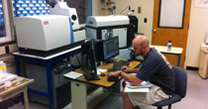|
► W.M Keck Plasma Laboratory
The W.M. Keck Collaboratory for Plasma Spectrometry in the College of Earth, Ocean and Atmospheric Sciences is an important facility for VIPER members and many other users. The lab has a NuPlasma Multicollector ICP-MS, and Axiom single collector ICP-MS, two Thermo Xseries II quadrupole ICP-MS instruments and a Leeman-Teledyne ICP-OES. Class II clean lab facilities are also available for low blank chemical processing. A Photon Machines G2 short pulse ArF Excimer laser system is used for laser ablation analyses using the multicollector and quadrupole ICP-MS instruments. Many VIPERs use the laser ablation system for analysis of glasses, minerals and various inclusions in a range of igneous samples. For more details see our website or contact Adam Kent.
► Electron microbeam analyzer lab (Cameca SX-100, purchased 2003)
The Oregon State University Electron Microprobe Laboratory, located in Burt 150, utilizes and maintains a Cameca SX-100 Electron Microprobe equipped with 5 wavelength dispersive spectrometers (WDS) and one energy dispersive spectrometer (EDS) with thin window for light element detection. The probe has high intensity dispersive crystals for high sensitivity trace element analysis, and a high precision sample stage with 0.1 um stepping capability. The probe is equipped with Cameca Peak Site analysis and imaging software. The SX-100 is capable of quantitative analyses from Z = 4 (Be) to 92 (U) uranium. It has the capability for high-resolution elemental mapping and trace element analysis at low concentrations (generally to 100’s of ppm). The probe has a high speed back scattered electron (BSE) imaging system, transmitted and reflected light imaging, and automated calibration and analysis. The Electron Microprobe Laboratory maintains a wide range of in-house calibration standards for quantitative analyses of silicates, sulfides, carbonates, oxides, and alloys. For more information, contact Frank Tepley.
► OSU Argon Geochronology Laboratory
Radiometric ages for volcanic, plutonic, metamorphic and sedimentary rocks and minerals have been determined in this laboratory since the early 1970s. The 40Ar-39Ar total fusion and incremental heating methods are used exclusively. Support is provided by research awards and payment for services from external users. We prepare samples using rock crushing, sieving, ultrasonic cleaning, Frantz magnetic separation, hand-picking and (when appropriate) acid leaching. Samples are irradiated in a flux of fast neutrons at the 1 MW OSU TRIGA reactor (http://radiationcenter.oregonstate.edu/). We measure Ar-isotopic compositions of air, monitor minerals and sample unknowns using an ARGUS VI multi-collector mass spectrometer, connected to a CO2 laser gas extraction line. In September 2014 we began commissioning a second ARGUS VI multi-collector mass spectrometer, to be attached to a low-volume extraction line for high-precision single-crystal analyses. See further details at the lab website. To schedule analytical work please contact Dr. Anthony Koppers (akoppers@coas.oregonstate.edu) or Dr. Robert Duncan (rduncan@coas.oregonstate.edu), or lab manager Dan Miggins (dmiggins@coas.oregonstate.edu).
► Noble Gas Geochemistry Lab
Noble gases are used to study a wide range of geological problems. The primary instrumentation in CEOAS includes a noble gas mass spectrometer (Noblesse model made by Nu Instruments), a high-temperature vacuum furnace and an on-line crushing system for the extraction and analysis of noble gases in terrestrial materials. See further details at our website.
► Stable Isotope Lab
Alan Mix (OSU-COAS) operates and maintains three gas-source mass spectrometers, including Finnigan 251 and 252 for static mode, and a Delta Plus for Continuous Flow mode (purchased by NSF, Mix et al., ). The latter has C, H, N, and S isotope capabilities via a Carlo Erba EA/GC that has both an oxidation furnace (for organic C, H, & S) and reduction furnace for organic (N). NSF funds will allow purchase in 2003 of a Finnigan TC/EA (carbon reduction 1500C) furnace for analysis of H, O, and C isotopes from a variety of sulfate, carbonate, and hydrous minerals). This instrument would interface with the existing Delta Plus CF mass spectrometer.
► Sample prep & photography
The Dept of Geosciences houses standard rock crushing, sawing, and mineral separations labs. Petrographic microscopes (transmitted & reflected with standard photography are available), and was outfitted in 2002 with a Nikon DX-100 (12 Megapixel) digital camera and computer interface with imaging software.
► Vacuum lines for O, S, & H extraction from rocks and minerals
The Dept of Geosciences houses vacuum lines (Dilles and Grunder) for extraction of oxygen via laser fluorination using ClF3 and a CO2 laser, and conversion of O2 to CO2 for isotopic analysis. They also maintain a vacuum line for extraction of hydrogen (U-reduction) from minerals and fluids for isotopic analyses, and a vacuum extraction line that allows extraction of sulfur from sulfides for isotopic analyses.
► USGS-type gas flow fluid inclusion heating/freezing stage and Vernadsky high temperature stage, Olympus BX-60 microscope, and video system
The Vernadsky stage is designed for heating and rapid quenching of melt inclusions.
► Ore deposits hand sample and mineral collection
Maintained by John Dilles and incorporates C.W. Field collection; it includes samples from more than 30 porphyry copper deposits of the American Cordillera, as well as numerous other ore deposits.
|

